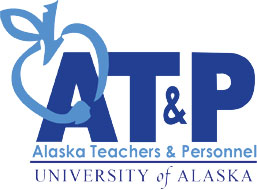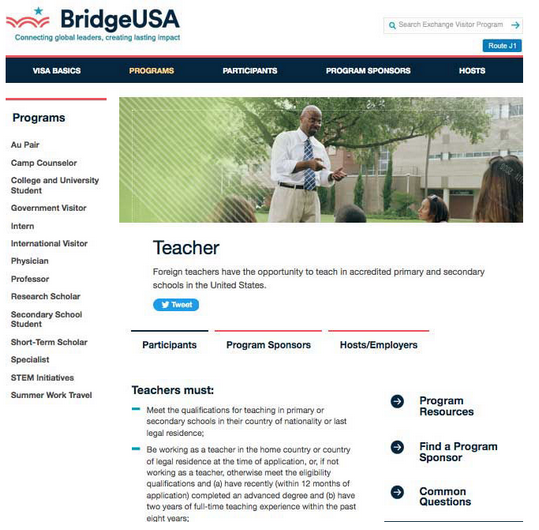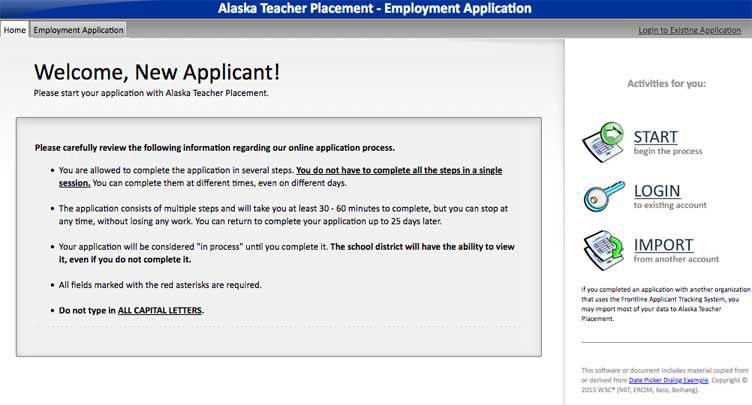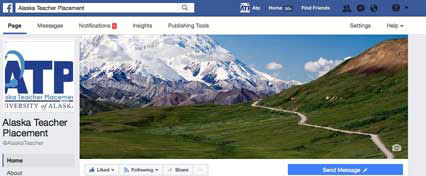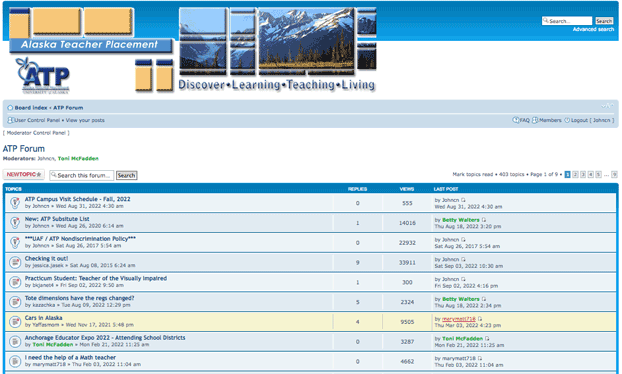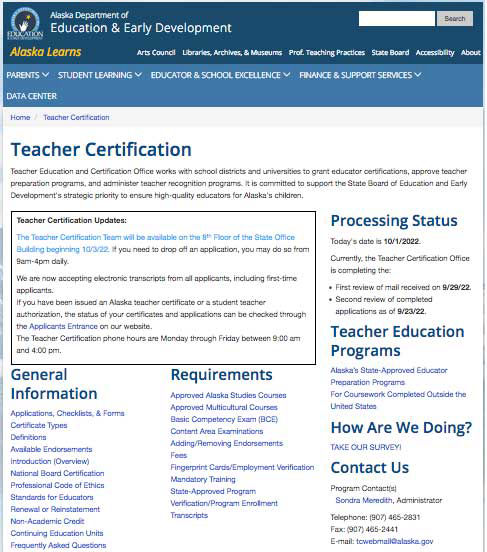

Information for Foreign Teacher
Candidates
Over the last few years we have seen an increasing number
of teachers from other countries working in Alaska for
school districts. This is because there is a shortage of US
teachers nationally. Most often, these teachers are working
on J-1 visas, and there may be 200 or more foreign national
teachers - most from the Philippines - working in Alaska
schools for the 2022 school year.
Visa Information
The most common visa used by teachers working in Alaska is
the Exchange Visitor (J) series non-immigrant visa category.
Nearly all current teachers from overseas in Alaska that we
are aware of are on J-1 visas. There are other visa types (H-1B
/ EB-2
& EB-3), but these are far less popular with
Alaska school districts due their complexity, and the
unpredictable number or "cap", and very tight timelines for
August school start dates. We won't discuss these visa types
here, but the embedded links above go to official sources.
Basic Steps for J-1 Visa Candidates
There are three important phases for overseas teachers
seeking to work in Alaska. Although we outline the
steps here, the only one ATP can help with is the last one:
your actual job search.
Whether you find an Alaska job or not depends on your
specific qualifications and experience, your patience and
skill with rules and paperwork, and perhaps most
importantly, your ability to find a school district that
needs your skills.
Note: We do not do direct hiring of teachers,
but are the official education job board service for Alaska
school organizations. We are not experts about
immigration matters, visas or work regulations. All job
offers are between individual school districts and the
teachers themselves, but we provide this page as a resource
for overseas teachers exploring work in Alaska.
Also, please realize that while we do wish all candidates
luck in their job search, ATP does not endorse, or have an
official relationship with any employment agency or sponsor
recruiting or placing teachers from other countries.
![]() Getting Your Visa Sponsor
Getting Your Visa Sponsor
The US Department of State has very specific requirements
for work visas. For J-1 visas,
there are approved "sponsor" agencies allowed to recruit,
screen and place teachers in US schools from overseas.
You must choose a sponsor agency to handle your credential
screening, assist with paperwork, and get your visa
approval. The sponsor assists you with the paperwork and the process,
but you can't get actual visa approval until getting a job offer from a school district.
![]() Finding a Job in an Alaska School
Finding a Job in an Alaska School
This is the key! You have to find a school or school
district that wants to hire you. We can help with
this, but not directly. Think of ATP like a "dating app" in
that both schools and candidates have accounts, but have to
find each other. Schools post their jobs in our
system, and search our database of free Candidate
Profiles. You can apply for jobs, and reach to schools
to introduce yourself as a candidate.
![]() Getting Alaska Teacher Certification
Getting Alaska Teacher Certification
Once you sign a job contract - which is required get your
visa - you need to get certified (licensed) to teach in
Alaska. We have a page
that explains this process. It is tricky for overseas
candidates, so read more below. This usually has to be done
AFTER you arrive in Alaska, but you have to have everything
ready to go!
J-1 Visa Program: BridgeUSA
The J-1 is for individuals approved to participate in
work-and study-based exchange visitor programs. In October,
2020 the U.S. Department of State re-branded the J-1 as the
BridgeUSA
program.
The purpose of the Exchange program is for teachers to
sharpen their skills and participate in cross-cultural
activities in schools and communities. The one-year job
period can be extended twice for a total of three years.
Statistics show that most Exchange Visitor visas in the
Teacher category were issued last year to teachers from the
Philippines. Other countries well represented included both
Jamaica and Columbia, and there were 20 different nations
involved.
J-1 Requirements
The following checklist of eligibility is adapted from the US State Department website, and candidates must meet all of them to qualify for the Exchange Visitor Program's "Teacher" visa. J-1 candidates work with their sponsor agency to document you meet eligibility criteria. Your designated sponsor is responsible for assisting and advising you on all matters regarding your exchange visitor program. What we have here is simply an overview.
Once you get a job offer, your sponsor agency arranges your "Certificate of Eligibility for Exchange Visitor (J-1) Status" form (DS-2019) so that you can schedule your interviews at the local US embassy or consulate for final visa approval. The same DS-2019 is also what allows you to get a Social Security Number and therefore makes certification / licensure by the Alaska Department of Education possible.
To meet the requirements, candidates must:

Meet teacher qualifications in
your own country

Either be working as a teacher currently, or (*) have recently finished an advanced degree within last 12 months, and also have worked at least two of the last eight years full-time as a teacher.


At least 24 months of full-time teaching experience is required. The requirement says "related professional experience" can also be counted, but frankly, districts are going to look for more than the minimum for J-1 hires in most cases.

Meet state requirements
Each state in the US has their own teacher licensing / certification requirements. Alaska's certification process and requirements are explained on our Getting Certified page, but it's the Alaska Department of Education's Teacher Certification Office that has the official information.

Be of good reputation and character
Your sponsor agency will work with you to collect letters and references needed to document you are well regarded in your local community.

Be seeking a full-time job as a temporary exchange participant

Demonstrate proficiency in the English language
For obvious reasons, school districts will want your spoken and written English to be good enough to routinely communicate with your students and coworkers. This means that a significant accent, or even having informal styles of spoken English used in your own country, could prove to be an issue when meeting with school district hiring staff. It could also be a problem with US Embassy bureaucrats when you have your visa interview. You are going to want to practice standard usage, and speak slowly and clearly. ;-)
Begin Your Alaska Job Search!
ATP uses the Applitrack database system, which allows all of the school districts and other agencies in Alaska to find your application, resume, letters of reference and other supporting documents. We have a more detailed explanation of how our system works on our ATP Consortium Job Search page. This resource has links and built in tools to learn about, and search for jobs from all ATP Consortium members.
There is also our live ATP Job Bank quick search page for only currently open positions.
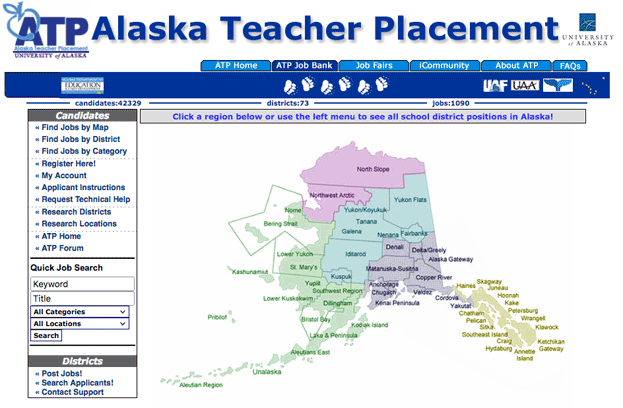
Participate in ATP's Community Connections
It is not realistic for most foreign candidates to attend
a face-to-face ATP Job Fair. But, we also hold ATP
"Virtual Chats" via Facebook Live and Zoom at various
times during the year. The interface allows live
interaction over video (Zoom) and live text chat (Facebook
Live & Zoom). These events - which are recorded for offline viewing - are a great way for both overseas and US-based candidates to learn about working and living in Alaska, and to interact directly with school district recruiting teams. You can research districts that you are interested in, or learn about others, by listening to the presentations by their staff, and the questions candidates ask. There is a free archive of prior ATP Virtual Chats that you can watch whenever you'd like.
Scan through our ATP Forum Archive to see prior candidate common questions and answers.
Alaska is not like other US states. Make sure you take time to learn about Alaska, about the Alaska's five regions, and research locations. Then, reach out to schools and districts you are interested in politely, but persistently.
Getting Certified for J-1 Visa Applicants
The third step in your process, after you find a district
in Alaska to offer you a job, is to get certified
(licensed) teach here. Unlike most countries, each state -
our political units which are like provinces - set teacher
certification / licensing rules. All states have their
own, slightly different certification criteria, and a
process through their own Department of Education, so this
is not just in Alaska. American teachers have to navigate
the rules of every state if they want to move. You will,
too! No matter what else you read here or on our Getting Certified page, from a sponsor agency, or any other website, your specific questions about your files, and getting your license to teach in Alaska should be directed to the very helpful staff at the Teacher Certification Office at the Alaska Department of Education in Juneau. The Teacher Certification Office (linked above) is the only official source of all certification information, and they have a small office in Juneau which will decide your status. Sondra Meredith and her staff are not like most government bureaucrats. Once you have a job, they will work with you and your employer to jump start the process and make sure you are getting what you need so that you can teach. Note: Staff shortages and high demand mean that current (December 17, 2023) processing times can be 8-10 weeks.
J-1 Candidate Certification Tips
It is important to note that your Alaska Teacher
Certification application has to be sent in a single
packet or envelope. This sounds like a small thing, but it
isn't! It means the completed application forms for certification, your foreign credential evaluation original copy, all of your supporting documents, and your fingerprint card (see below) have to be in the same envelope with payment for the fee. The documents must also be notarized prior to sending, and because this means different things in different countries, Alaska EED provides some details about what they expect (Word document).
If any part of your application is missing, they will be sending it back to you, so it's critical to get it right by following the checklists that the Teacher Certification Office provides.
Social Security Card Confusion!
All teachers who apply for certification in Alaska must
undergo a background check, including getting
fingerprinted on a very specific Federal Bureau of
Investigation (FBI) form called the FD-528.- Alaska Background Check - Alaska
Department of Education site information
page
- FBI Fingerprint Form (FD-528)
- FD-528 Form (PDF)
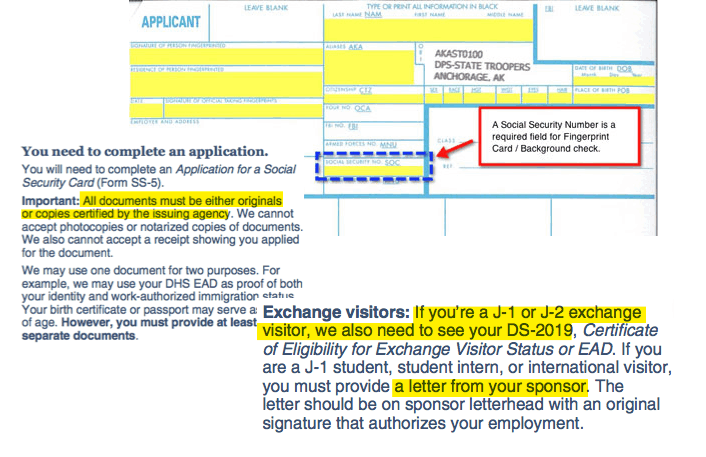
- Social Security Number for Non-citizens (PDF)
Finding an FBU Near You!
Federal Benefits Units
Overseas Federal Benefits Unit (FBU) offices provide
services for the USA's Social Security Administration,
Department of Veterans Affairs, Office of Personnel
Management, Railroad Retirement Board, Medicare, and
Department of Labor. So, if you are a J-1 candidate, your
sponsor will provide you with guidance, you'll take
your DS-2019 with you to the FBU appointment to apply for
your Social Security number.
This page is from the official Social Security website and
lists the FBUs by country around the world:
https://www.ssa.gov/foreign/foreign.htm
FBU Example (Philppines)
https://ph.usembassy.gov/services/social-security/
This overview of Social Security information for overseas
citizens is from Americans Abroad, another organization, not
the actual Social Security offices, but it might be helpful
to some. Make sure you verify with official sources
Partial List of Alaska School Districts Hiring J-1
Candidates
We have not maintained an official list, but some
districts have reported having foreign teachers under J-1
visa programs, and news reports have also mentioned that
overseas teachers have positions with the districts
mentioned below. In 2021, in fact, Alaska's Governor
Dunleavy
welcomed over 100 teachers from the Phlippines alone,
and these were placed in various districts throughout
Alaska. The number of J-1 visa teachers seems higher
for the 2022-23, but no firm numbers are yet available.
Keep in mind that this is not a complete list, and that
district needs may vary year-to-year:
- Anchorage
- Bering Strait School District
- Chatham School District
- Fairbanks
- Iditarod
- Kake
- Kashunimuit School District
- Kodiak Island
- Kuspuk
- Lower Kuskokwim
- Lower Yukon School District
- North Slope
- Northwest Arctic
